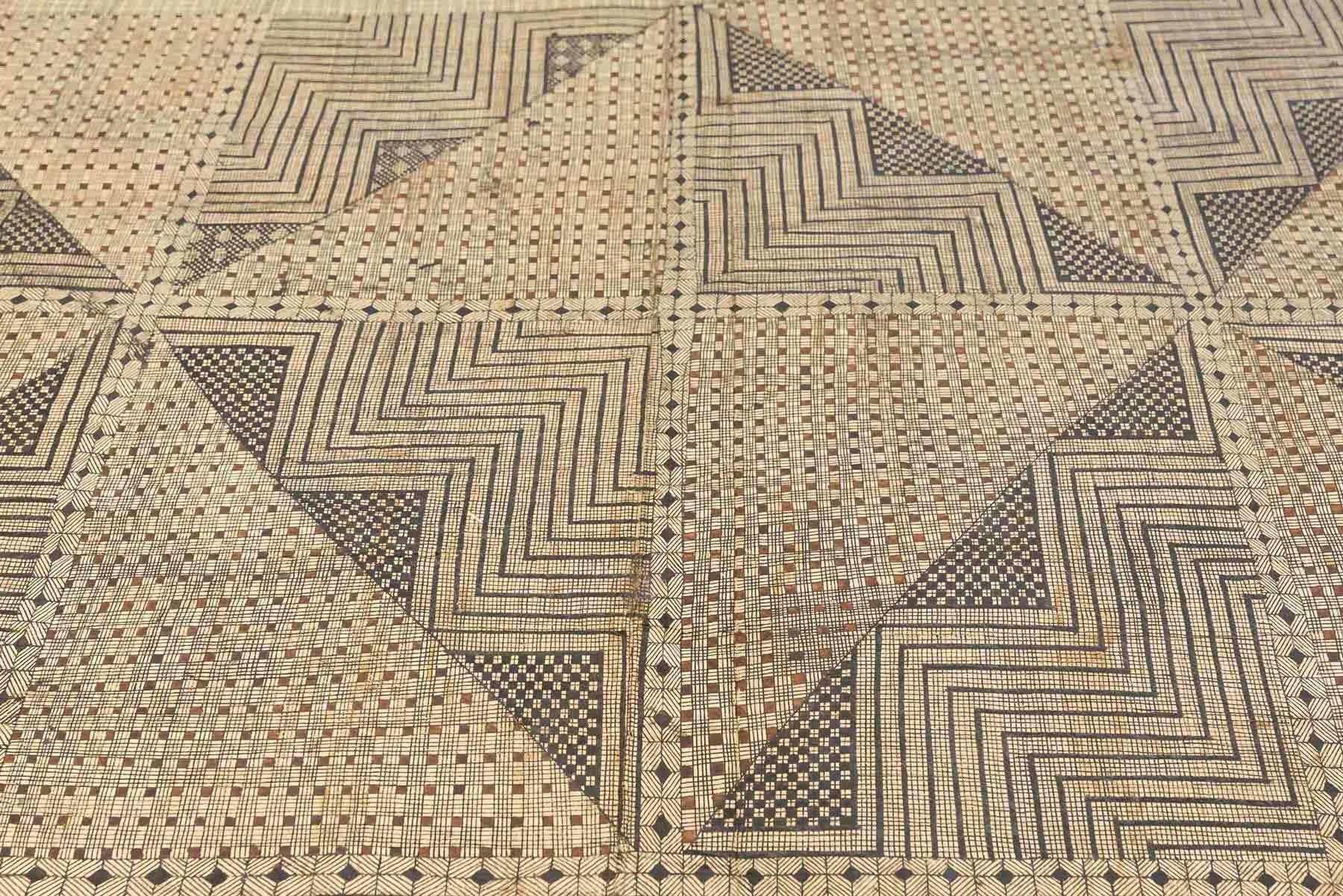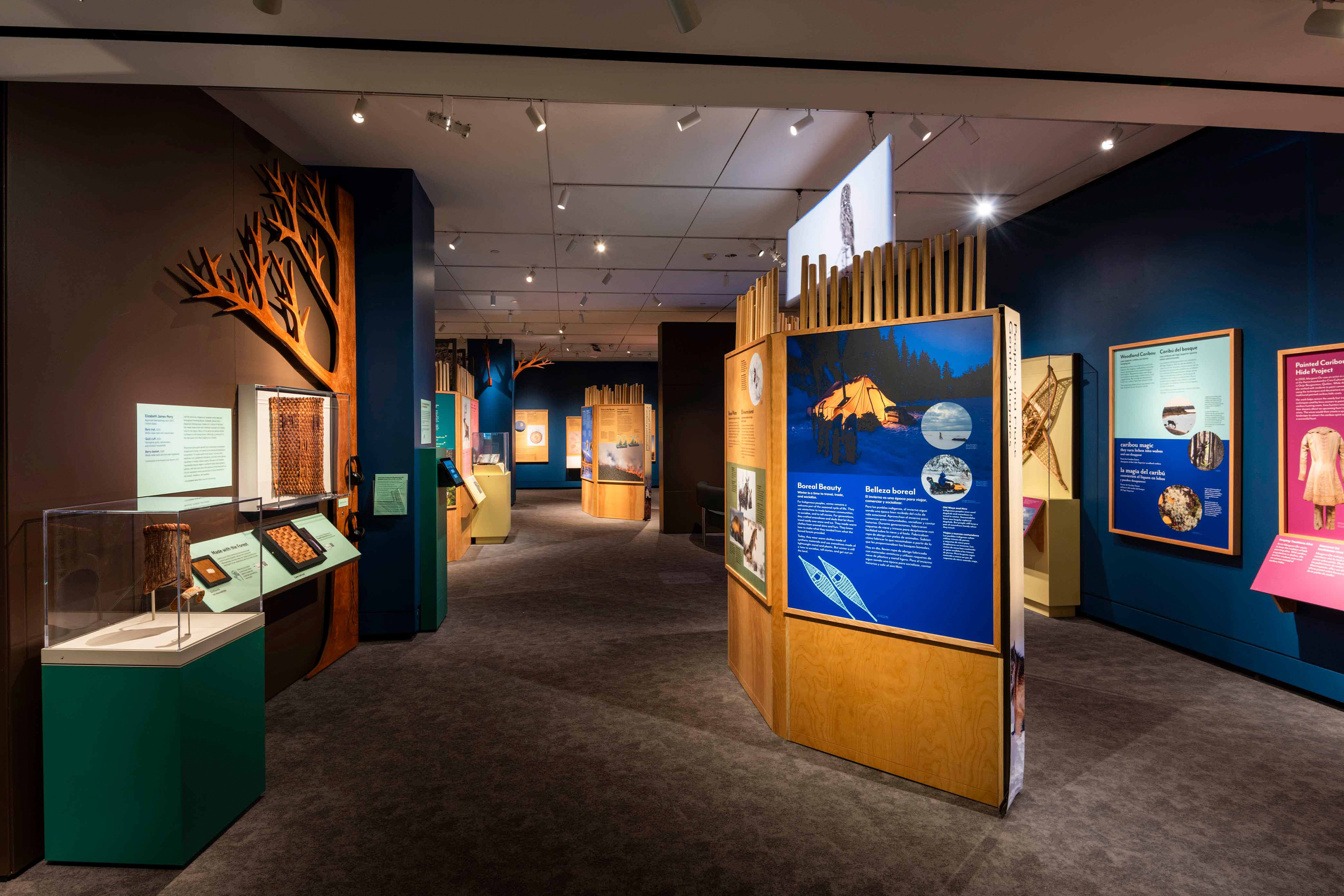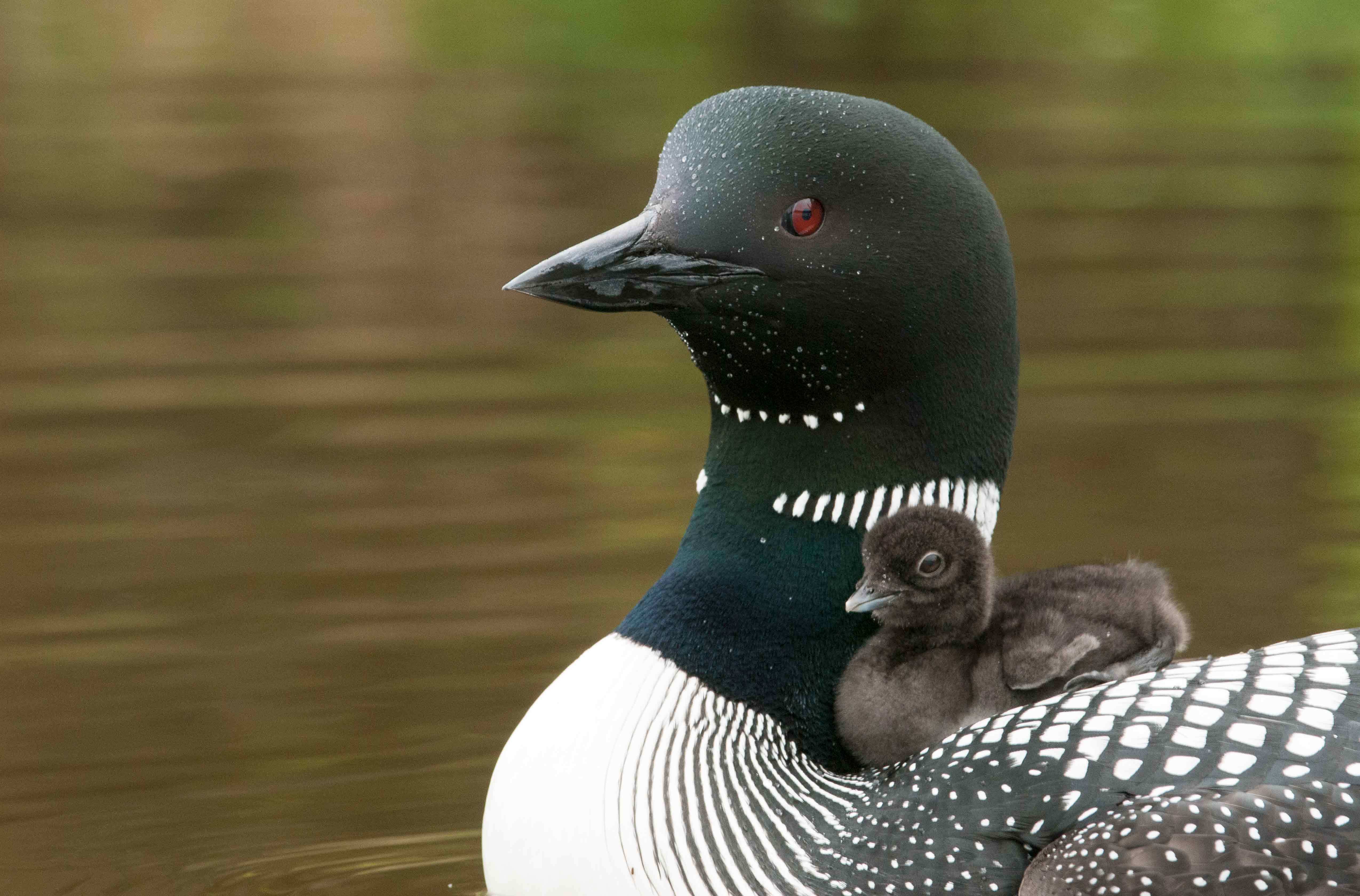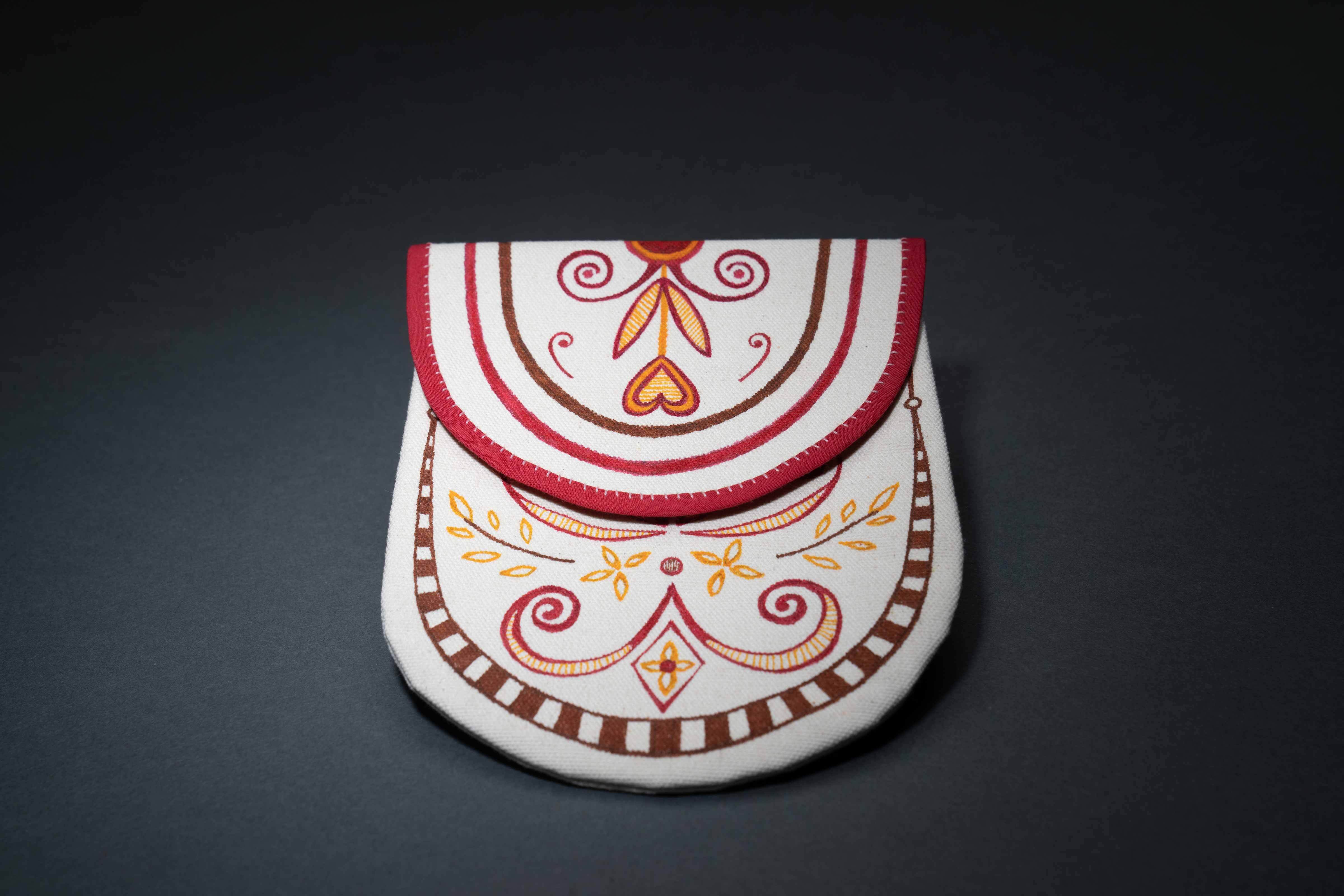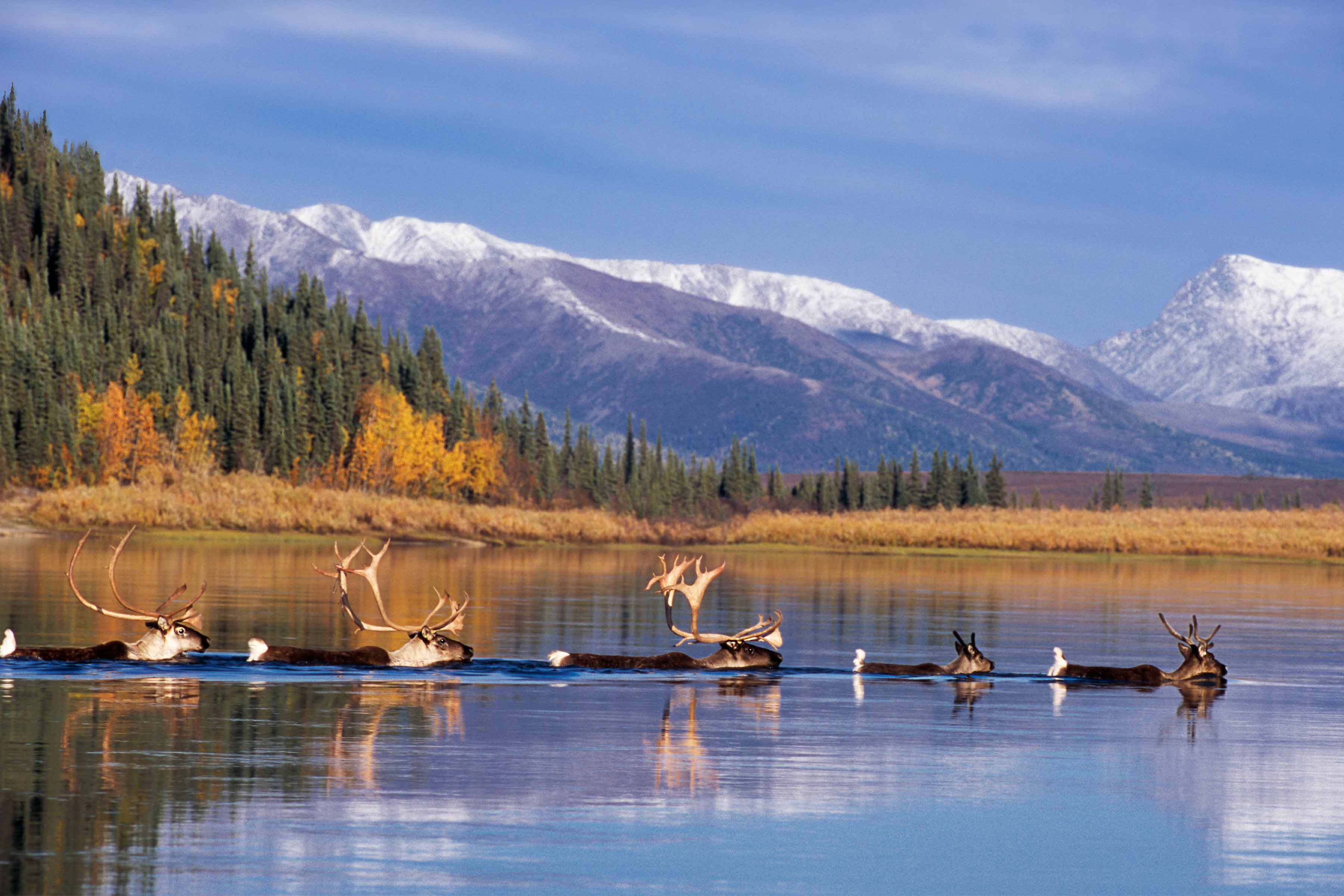
CONNECTED | Aug 21, 2025
Journey deep into the trees with Knowing Nature: Stories of the Boreal Forest
We recently sat down with Jane Winchell, the Sarah Fraser Robbins Director of the Dotty Brown Art & Nature Center and PEM’s Curator of Natural History, to talk about the climate-focused exhibition Knowing Nature: Stories of the Boreal Forest, which opened on July 26. She highlighted some of the exciting interactive features and collection connections visitors can find in this show about Earth’s northernmost wilderness.
Caribou swimming across a lake. ©Tom Walker. All Rights Reserved.
Q: Where, exactly, is the boreal forest? And why is it important to learn about?
A: The boreal forest forms a ribbon around the top of the globe just below the Arctic Circle that runs across Alaska, across Canada, Europe, across Russia, and is the largest forested area in the world. It's the largest biome in the world. The boreal forests in North America are the largest intact forests on the planet, so really significant territory.
As for why the boreal forest is important, the list is long — this planet would not be livable without the boreal forest. It offers a really essential ecosystem for an incredible variety of animal species. It's where over 3 billion of our migratory birds in North America go each spring to breed and raise their young. Over 50% of our bird species, even the backyard birds that we have here in Massachusetts, will go to the boreal to nest.
It is where two to three times the carbon is stored that would be stored in tropical forests. Although people often think of tropical forests being this incredible carbon sink that's helping to regulate the climate, the boreal forest is actually even more significant in that way. It's also an incredible repository for fresh water: 25% of the world's fresh water is in the boreal forest. And last but not least, it's home to hundreds of Indigenous communities that have lived in the boreal for millennia.
Inside the exhibition. Photo by Kim Indresano/PEM.
Q: What else do you hope people take away from the exhibition?
I'm really excited about people coming and just gaining knowledge about this place and an appreciation and a feeling for what it is, because it is such a distinctive place on the planet. People can actually get glimpses of it by going to Northern New England. You'll start to get into those evergreen forests where it's mostly pine, spruce and fir, and the ground is covered in moss. Those are little windows into the boreal. You can encounter boreal forest islands as you go up in altitude. If you hike in the White Mountains or even if you go out to the ridge of Mount Greylock, you will get this little mini experience of this huge, vast, remote ecosystem.
We're also so pleased to be able to present Knowing Nature as a bilingual exhibition in English and Spanish. All of the panels are either in both languages, or available via a QR code at each station. We also have a Spanish-language binder at the Information desk that will provide translations if someone doesn't come with a device that can scan a QR code.
We're really pleased about the accessibility, both in terms of the different communities that we want to feel welcome in the exhibition, and also the nature of the show itself, which was created with intergenerational audiences in mind. I feel like all of that just puts out a big welcome mat for people coming into the exhibition.
A loon with its chick. © Tom Walker. All Rights Reserved.
Q: What's hopeful about this exhibition?
A: I would hope there's a lot of hope in this exhibition. It starts with people knowing what this place is, having an appreciation for what this environment is, because without that, it just feels removed. I feel like with the experiences in the exhibition, the immersive moments, that people will get more of a sense of, "Oh, this is a real place. Real animals live here. People live here."
That there's lots of projects going on right now that are directed at the preservation of large regions of the boreal forest. To me, that generates a lot of hope. Many of these efforts are Indigenous-led. Indigenous communities are the ones who have been living sustainably in these environments for thousands of years and have that knowledge.
That's one of the threads also within the exhibition: the wisdom of traditional practices, and of Indigenous communities who are living in the boreal forest and offer us a window into how to live more sustainably in these environments.
Q: What are some of the things that visitors will get to experience in Knowing Nature?
A: We wanted to create a variety of experiential, immersive and interactive components. Visitors of all ages like to have those moments where they can feel connected. When you come up to the Art & Nature Center, one of the first things you'll encounter is a giant 6-foot-by-9-foot dried moss wall. It was produced by a company called EnviroGreenery based in Nashua, New Hampshire, using sustainably harvested moss, mostly from southern New Hampshire. It's a wonderful example of something that connects right to the essence of the show from the beginning.
In the same alcove is a display where you can watch aerial footage of the boreal forest to give you a sense of the area in different seasons, and then a wonderful birch bark canoe model from the museum's collection that dates back to about 1800. That object speaks to the fact that the best way to traverse the area historically, and even today, is by water. It’s crisscrossed by rivers. There are 600,000 lakes and ponds in Canada alone. Traditionally, this would have been like a highway system in the summer for Indigenous people to get from place to place. Canoes were a significant form of transportation.
Then, when you get into the main exhibition area, you are going to be experiencing the boreal forest through the seasons, starting with spring and moving through the year, surrounding an immersive hub that puts you inside the sounds and the feel of the trees. We have a wonderful animal track table on a riverbank in the Canadian boreal forest with sample tracks from caribou, beaver and wolf for people to play with, and two games: a boreal digital game and a boreal bird migration challenge game.
Q: Can you describe some of the works in the show that are created by Indigenous artists?
A: There's a range of wonderful pieces in the exhibition. A painted canvas bag that honors a long-standing Cree and Chisasibi First Nation tradition of painted caribou artwork; Oji-Cree moose hide earrings with beadwork on them; traditional Cree and Ojibwe basketry. There’s a contemporary birch bark canoe model that parallels our historic one in the moss alcove.
Another wonderful installation in the show is by local Aquinnah Wampanoag artist Elizabeth James-Perry, who created three different works using materials that she harvested herself: a porcupine quill cuff, a bent-bark berry basket, and an inner bark woven cedar mat. Those are displayed with some touchable samples of a bark mat and some moose hide with quillwork on it. People can listen to recordings of the artist speaking about herself as an Indigenous person, her relationship with the forest and how she is part of nature, which is also reflected in the messaging of the First Nations artists who are participating from Canada.
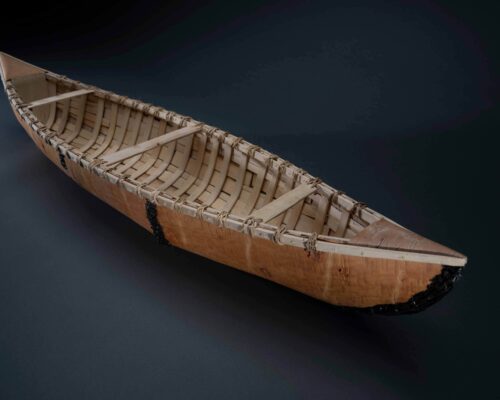

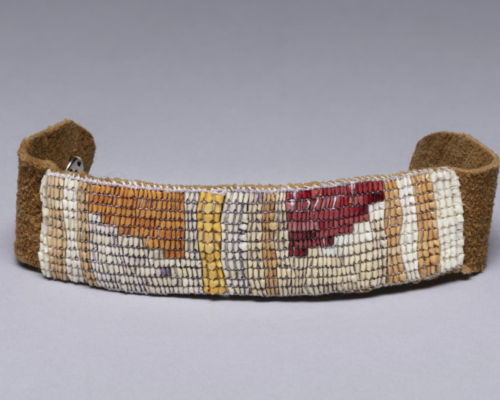
Q: How is this exhibition connected to PEM’s Climate + Environment Initiative?
A: The Climate + Environment Initiative at PEM is an ongoing, multidimensional effort within the museum that's looking at our exhibitions, our programs and ourselves as an institution, and what we are doing as a whole. In this exhibition, for example, we are repurposing a number of construction materials. We combined efforts with the exhibition design team to be as sustainable as possible in our production.The generator of this show, the Smithsonian Institution Traveling Exhibition Service (SITES), was also very mindful of the materials they were using, like panels made from sustainable Baltic birch. We have a panel in the exhibition that references the ways that PEM and SITES are working to have this show be as environmentally friendly as possible.
But first and foremost, PEM’s Climate + Environment Initiative is getting people to realize that we are all interconnected. We are interconnected with our environment. We are interconnected with each other. We are all part of one system. Starting there is a way to then have people feel, first, like this is important, and second, like they can take action. That's the case in this exhibition — you will find ways that you can be advocating for the boreal forest. We know that that's something people are asking in general: "What can I do that's going to actually make a difference?"
At the “The Boreal Forest and You” wall, when you've looked at these options for what you might do in support of the forest, we’re inviting you to choose an action step, make a pledge yourself and then hang that on our pledge tree. Over time, that will reflect a community of people who are saying, "Yeah, the boreal forest matters to me. These are things I'm doing now for that environment."
With so much information coming at us, it can feel daunting, and yet there are basic steps that we can each take to be moving forward and having a positive impact.
Knowing Nature: Stories of the Boreal Forest is on view July 26, 2025 to September 27, 2026 and is developed by the Smithsonian Institution Traveling Exhibition Service and made possible by the National Audubon Society, with additional support from The Anders Foundation, Charlie and Nancy Hogan, and Anne C. Madison. This exhibition at PEM is made possible by Carolyn and Peter S. Lynch and The Lynch Foundation. We thank Jennifer and Andrew Borggaard, James B. and Mary Lou Hawkes, The Creighton Family, Chip and Susan Robie, Timothy T. Hilton, and an anonymous donor as supporters of the Exhibition Innovation Fund. We also recognize the generosity of the East India Marine Associates of the Peabody Essex Museum and the support and guidance of the Art & Nature Center Visiting Committee.


PEM’s Atrium Café partners with Gourmet Caterers for more sustainable snacking
6 min read

Blog
A conversation with the organizing curator of Narwhal: Revealing an Arctic Legend
8 Min read

Blog
‘Beyond words’: PEM’s garden team shares excitement over new arboretum certification
8 Min read

Blog
Behind the scenes of caring for PEM’s Pacific barkcloth collection
5 min read
